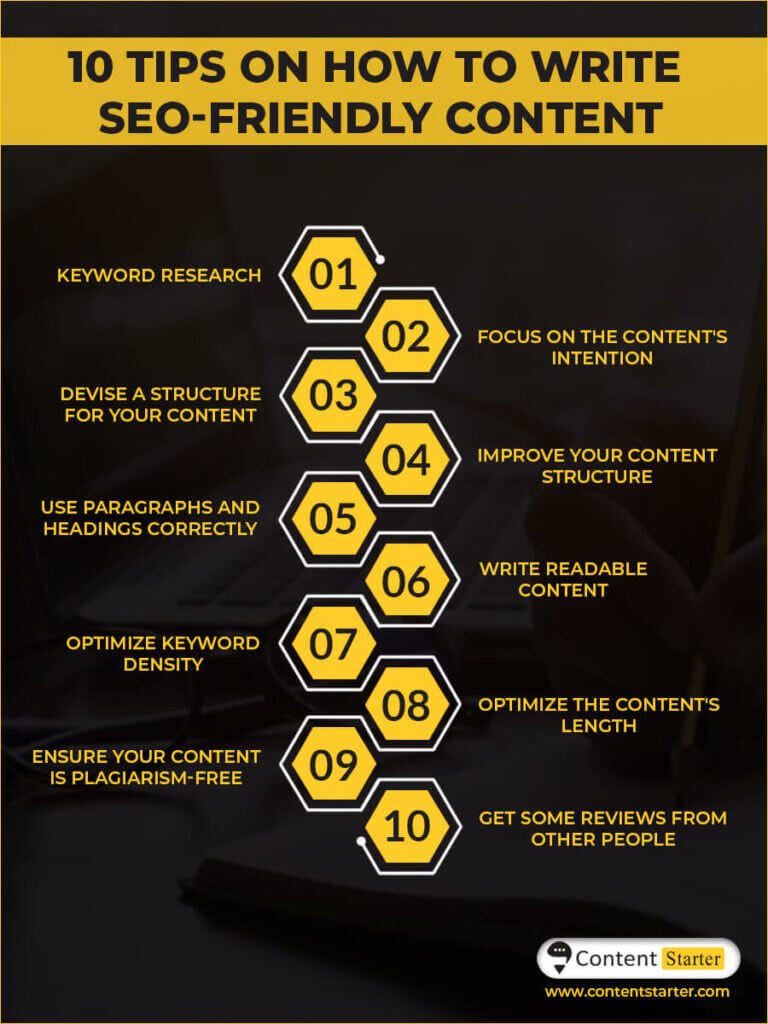10 Amazing Tips That Help SEO Content Writers
Every business wants organic growth. And there is a way to reach your target audience organically. SEO is one factor that can increase a business’ web traffic, help in lead generation and conversions. Therefore, it’s a skill every content writer must have to help their clients better. But how do you use SEO in content writing? Well, our expert SEO content writers have spilt the beans about: –
- What is SEO content writing?
- What is an SEO content writer’s job?
- How to implement SEO in content writing?
Let’s jump right into learning all about content writing and SEO.
- 10 Amazing Tips That Help SEO Content Writers
- What Is SEO Content Writing?
- How To Implement SEO In Content Writing?
- Keyword research
- Focus on the content’s intention
- Devise a structure for your content
- Improve your content structure
- Use paragraphs and headings correctly
- Write readable content
- Optimize keyword density
- Optimize the length of your content
- Ensure your content is plagiarism-free
- Get some reviews from other people
- Conclusion
What Is SEO Content Writing?
SEO content writing is writing blogs, articles, and website write-ups to help them rank on search engines. The aim is to: –
- Solve the target audience’s problem.
- And simultaneously rank on search engines.
The first is done by thorough research and writing impeccable content. The latter is done using small tips and tricks to appear on the first few pages of search engines.
But why is SEO important? The answer is simple: it’s the cheapest, most appealing, and organic way of appearing in front of a business’s ideal customers. Thus, the ROI is higher and profitable for the company. The long-term effects of well-written SEO content are phenomenal for a business.
An SEO content writer identifies customer’s pain points, writes well-researched content that solves those problems, and follows tactics to help the content rank.
How To Implement SEO In Content Writing?

Keyword research
How do you identify the pain points of your audience? Once you know those pain points, you can proceed to solve them. Thus, you need to conduct keyword research. Keyword research is looking for phrases, terms, questions, etc., that the target customers search for on the internet.
Here’s how you pick the right ones:
- The search volume of the keyword must be high.
- The competition must be low.
- The SEO difficulty score must be low too.
If your keyword list has only keywords that satisfy the above conditions, your content writing SEO strategy is good to go. Unfortunately, that rarely happens. So, you must find a blend of keywords and experiment with them. Keep a healthy mix of short keywords and long-tail keywords.
For a blog, or webpage a list of 10 keywords is sufficient. However, keep only 3-5 focus keywords.
Semrush is used to conduct keyword research, click here to read its review.
Focus on the content’s intention
The most crucial part of SEO content writing is focusing on the intention of the content. You have to be clear about which pain-point you are solving for your audience, the central solution you are offering them, and what you want to encourage them to do. Clarity on these three questions is the difference between mediocre and premium content writers.
Something that will help you answer the first question is the keyword research you did. Questions and phrases you noted in the research phase will give you a glimpse into the queries your audience is searching for on the internet.
Devise a structure for your content
Every content piece needs a skeleton. Because without a frame, the message will be unclear, and your communication will be all over the place. Thus, create a structure for the blog, article, or web page you are writing.
Usually, there is an introduction, a brief explanation of the topic, why the problem is essential, steps to solving the problem, and a conclusion. A clear structure will help you while writing the blog, help your reader’s while reading the blog, and help the search engines understand your blog.
Improve your content structure
You now have a fair idea about your blog, but now it’s time to make the blog better. Search the topic and open the first-page search results. Read each article and see if your blog includes those points or not. Chances are you missed something. Add all the points you missed. Go even deeper and search for the given topic on YouTube or any other site where you might find relevant information (Quora, Reddit, Pinterest, etc.).
Add all the new information you find, and you are ready to outrank the competitors. Why go through all this hassle? Because exceptional content goes above and beyond to solve a problem. Therefore, an SEO content writer has to go the extra mile to help the end-user.
Use paragraphs and headings correctly
You have new information and your old outline. Make a new outline and start writing. But, before you begin writing, you need to know the importance of paragraphs and headings in your blog or article. While writing the headings, you have to keep in mind that many people skim the writing piece. Therefore, your headings should clearly indicate what the paragraphs under them are all about.
Moreover, your focus keywords should be part of the headings. Do not overdo it and ensure that it doesn’t hamper the readability of the text. It will be helpful from both the reader and search engine perspectives.
But wait, how does the algorithm differentiate between headings and paragraphs? Intuitively, it can’t; you have to specify it. And you specify it using heading tags. While writing, ensure that your heading has the H1 tag and the subheading has the H2 tag. If there are sub-headings within a sub-heading, it will have an H3 tag.
While writing paragraphs, make sure they are short to help the reader read them correctly. You have to apply some common sense here and ensure that the paras make sense while ending and beginning.
Write readable content
Our motive is to help the target audience and make it easier for them to read our blog. The easier it is, the higher chances of people reading the entire blog. Here’s how you can increase the readability of the article: –
- Introduce variety in your article
- Make it conversational
- Use transition words such as ‘thus’, ‘however’, ‘firstly’, etc.
- Use simple words and avoid complex words
- Vary the length of your sentence to kill monotony and introduce rhythm
- Use bullet points whenever possible. It makes reading easy.
- Write active-voice sentences and avoid passive-voice sentences.
The above points directly impact the SEO of your content writing, whether it is a blog, article, or web page. If there is one point you should remember from this entire blog, it’s this one.
Optimize keyword density
As the name suggests, it means how many times your chosen keyword appears in the blog per 100 words. So, in a 1500 word blog, if a keyword appears 15 times, it has 1% density. Ideally, your keyword density should be 1-2%. If you cannot reach the 1% mark, do not stuff your keyword to achieve it. It can hamper the readability of your writing and cause you more harm than good.
But, do not go above the 2% rate because it will cause your content massive harm and nobody wants that. Instead, you can use synonyms or, better yet, related keywords. This has twin benefits: –
- First, it will bring a variety to your content, and that will help the reading experience.
- Second, you can now rank for the other related keywords. Whenever someone searches for your focus and related keywords, your content should pop up.
Optimize the length of your content
As SEO content writers, you need to know that search engines prefer long articles. However, that does not mean you force long articles. Writing concisely with sharp articulation will improve the reader’s experience. So, keep in mind that it should be at least 300 words. But, try to go above and beyond to write a well-researched blog with tons of relevant information.
Add statistics, anecdotes, analogies, valuable insights, etc., to make your long article interesting. The art of storytelling will transform your blogs from boring to riveting masterpieces. If there’s anything, I can tell a young SEO content writer, learn how to tell relevant stories.
Ensure your content is plagiarism-free
If there is one thing that search engines hate, it’s plagiarized content. If everybody could just copy-paste content, then there would be no new information. Thus, it’s crucial to ensure your content is plagiarism-free. Not to mention the ethical and moral consequences of claiming someone else’s work as yours.
Should you check your content for plagiarism even if you wrote it from scratch? Yes, absolutely. Since there are more logs and articles you can think of, there are chances your writing may include some plagiarism. Use tools like Quetext, Copyscape or Grammarly’s in-built plagiarism tool to remove duplicity.
Get some reviews from other people
Before publishing, or submitting your work, let other people read it. While writing a blog or article, you spend a few days on it. Thus, you start to become emotionally attached and blind to some glaring mistakes. A set of fresh eyes can point to your mistakes.
Let us warn you, this process is painful and might hurt your ego. But taking critical feedback like a boss will help you become a better writer than the writer you were yesterday. Moreover, their suggestions will help you enrich the blog or article.
Conclusion
If I am candid, SEO content writing is challenging and definitely not a piece of cake. You have to ensure 10 different types of things and balance them all. But, with enough patience and cups of tea (or coffee), you can go ahead and excel as an SEO content writer now!
To conclude, we first talked about what is SEO, why it is essential and what is an SEO content writer’s job. We then discuss 10 tips to implement SEO in content writing work like blogs, articles, and web pages. Each recommendation was discussed briefly to give you an overview of how to go about it. Now you know what is SEO in content writing and have the proper knowledge to improve this skill.





